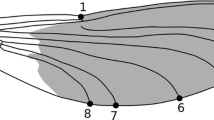Abstract
Tuberculatus quercicola (Matsumura) feeds on Quercus dentata Thunberg, and has mutualistic interactions with ants. Tuberculatus quercicola has two winged morphs in its life cycle, winged females appear in summer and sexual males appear in autumn. Previous studies have shown that wing loading (ratio of body volume to wing area) is higher for the winged females, because of ant attendance, resulting in extremely low dispersal. It is known that the nutritional quality of host plants is high in spring and autumn, when leaves are growing or senescent, and low in summer when leaves are mature. This study examined the effects of seasonal plant deterioration on the development of flight apparatus (wing size and flight muscle) of winged females and males. Moreover, field intercept traps were used to examine the extent of dispersal of males. The results showed that seasonal plant deterioration affected development of the flight apparatus of winged females, particularly flight muscle. Flight muscle development was significantly higher in winged males in autumn than in winged females. However, winged males were not caught in any of the traps. The different resource allocation to the flight apparatus of winged females and males is discussed.



Similar content being viewed by others
References
Abramoff MD, Magelhaes PJ, Ram SJ (2004) Image processing with imageJ. Biophotonics Int 11:36–42
Cortes T, Tagu D, Simon JC, Moya A, Martinez-Torres D (2008) Sex versus parthenogenesis: a transcriptomic approach of photoperiod response in the model aphid Acyrthosiphon pisum (Hemiptera: Aphididae). Gene 408:146–156
Dixon AFG (1970) Quality and availability of food for a sycamore aphid population. In: Watson A (ed) Animal population in relation to their food resources. Blackwell, Oxford, pp 229–247
Dixon AFG, Horth S, Kindlemann P (1993) Migration in insects: cost and strategies. J Anim Ecol 62:182–190
Hummon MR, Costello WJ (1992) Cell lineage of flight muscle fibers in Drosophila: a fate map of the induced shibire phenotype in mosaics. Roux’s Arch Dev Biol 201:88–94
Ishikawa A, Miura T (2009) Differential regulations of wing and ovarian development and heterochronic changes of embryogenesis between morphs in wing polyphenism of the vetch aphid. Evol Dev 11:680–688
Jockusch EL, Ober KA (2004) Hypothesis testing in evolutionary developmental biology: a case study from insect wings. J Heredity 95:382–396
Kobayashi M, Ishikawa H (1993) Breakdown of indirect flight muscles of alate aphids (Acyrthosiphon pisum) in relation to their flight, feeding and reproductive behavior. J Insect Physiol 39:549–554
Le Trionnaire G, Francis F, Jaubert-Possamai S, Bonhomme J, De Pauw E, Gauthier J-P, Haubruge E, Legeai F, Prunier-Leterme N, Simon J-C, Tanguy S, Tagu D (2009) Transcriptomic and proteomic analyses of seasonal photoperiodism in the pea aphid. BMC Genomics 10:456
Ramos S, Moya A, Martinez-Torres D (2003) Identification of a gene overexpressed in aphids reared under short photoperiod. Insect Biochem Mol 33:289–298
Shibata S, Ishida AT, Soeya F, Morino N, Yoshida K, Sato H, Kimura MT (2001) Within-tree variation in density and survival of leafminers on oak Quercus dentata. Ecol Res 16:135–143
Sokal RR, Rohlf FJ (1995) Biometry, 3rd edn. WH Freeman, New York
Yao I (2004) Effect of summer flush leaves of the Daimyo oak, Quercus dentata, on density, fecundity and honeydew excretion by the drepanosiphid aphid Tuberculatus quercicola (Sternorrhyncha: Aphididae). Eur J Entomol 101:531–538
Yao I (2010) Contrasting patterns of genetic structure and dispersal ability in ant-attended and non-attended Tuberculatus aphids. Biol Lett 6:282–286
Yao I (2011) Phylogenetic comparative methods reveal higher wing loading in ant-attended Tuberculatus aphids (Hemiptera: Aphididae). Can Entomol 143:34–43
Yao I (2012) Ant attendance reduces flight muscle and wing size in the aphid Tuberculatus quercicola. Biol Lett. doi:10.1098/rsbl.2012.0014
Yao I, Akimoto S (2002) Flexibility in the composition and concentration of amino acids in honeydew of the drepanosiphid aphid Tuberculatus quercicola. Ecol Entomol 27:745–752
Yao I, Akimoto S (2009) Seasonal changes in the genetic structure of an aphid-ant mutualism as revealed using microsatellite analysis of the aphid Tuberculatus quercicola and the ant Formica yessensis. J Insect Sci 9. http://insectscience.org/9.09
Yao I, Katagiri C (2011) Comparing wing loading, flight muscle, and lipid content in ant-attended and non-attended Tuberculatus aphid species. Physiol Entomol 36:327–334
Yao I, Shibao H, Akimoto S (2000) Costs and benefits of ant attendance to the drepanosiphid aphid Tuberculatus quercicola. Oikos 89:3–10
Acknowledgments
This study was supported by a Grant-in-Aid for Scientific Research (C) (no. 21570012 to IY) financed by the Japan Society for the Promotion of Science (JSPS).
Author information
Authors and Affiliations
Corresponding author
Rights and permissions
About this article
Cite this article
Yao, I. Seasonal changes in the flight apparatus of winged females and sexual males of the aphid Tuberculatus quercicola (Hemiptera: Aphididae). Appl Entomol Zool 47, 143–148 (2012). https://doi.org/10.1007/s13355-012-0101-2
Received:
Accepted:
Published:
Issue Date:
DOI: https://doi.org/10.1007/s13355-012-0101-2




